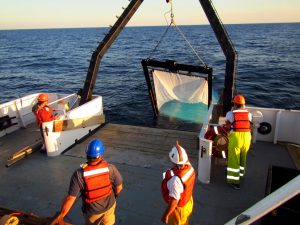Smithsonian Highlights Legacies of the Largest Habitat Survey in the Deep Gulf of Mexico
– MARCH 26, 2021
The Smithsonian’s Ocean Portal published an article that takes readers back to the Deepwater Horizon oil spill and the need to estimate its impact on the Gulf of Mexico’s ecosystems. Although acknowledged as being extremely diverse at that time, the habitats of the Gulf of Mexico – especially its deep-water habitats – were also acknowledged as being one of the least studied in the world.
Shortly after the spill an intense effort, led by Tracey Sutton at Nova Southeastern University, was underway to catalogue this region’s species. The habitat surveys were initially funded through the National Oceanic and Atmospheric Administration (NOAA) and continued later through the Gulf of Mexico Research Initiative and the NOAA RESTORE Science Program. The effort resulted in the collection of thousands of samples and the subsequent identification and cataloging of 900 fish species, with 186 of those having never been seen before in the region. The effort also revealed a disturbing decline (75-90%) in species that serve as food for large marine animals.
One of the legacies of this monumental effort is that the Gulf of Mexico is now one of the best studied midwater habitats in the world. Another legacy is that this effort made clear the importance of surveying the ocean’s habitats before disaster strikes, especially areas where there exists potential for other oil spills.
Read the Ocean Portal article Oil’s Legacy in the Open Sea at https://ocean.si.edu/conservation/gulf-oil-spill/oils-legacy-open-sea.
Here are related stories about this effort:
- Study Describes Foodweb Dynamics of Predatory Deep-Sea Fishes in the Gulf of Mexico
- Ten-Year Assessment Study Finds Increased Vulnerability of Deep Sea Fishes to Oil Exposure
- Science at Sea: Deep-Sea Research Informs Taxonomic Assessment of Gulf Fauna
- Discovering Vibrant, Dynamic Life in the Deep Gulf of Mexico
By Nilde Maggie Dannreuther. Contact maggied@ngi.msstate.edu with questions or comments.
************
GoMRI and the Smithsonian have a partnership to enhance oil spill science content on the Ocean Portal website.
The GoMRI is a 10-year independent research program established to study the effect, and the potential associated impact, of hydrocarbon releases on the environment and public health, as well as to develop improved spill mitigation, oil detection, characterization and remediation technologies. An independent and academic 20-member Research Board makes the funding and research direction decisions to ensure the intellectual quality, effectiveness and academic independence of the GoMRI research. All research data, findings and publications will be made publicly available. The program was established through a $500 million financial commitment from BP. For more information, visit https://gulfresearchinitiative.org/.
© Copyright 2010-2021 Gulf of Mexico Research Initiative (GoMRI) – All Rights Reserved. Redistribution is encouraged with acknowledgement to the Gulf of Mexico Research Initiative (GoMRI). Please credit images and/or videos as done in each article. Questions? Contact web-content editor Nilde “Maggie” Dannreuther, Northern Gulf Institute, Mississippi State University (maggied@ngi.msstate.edu).






